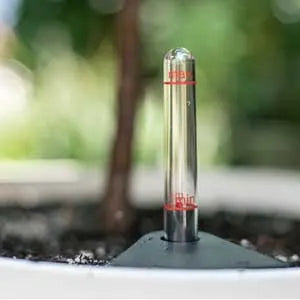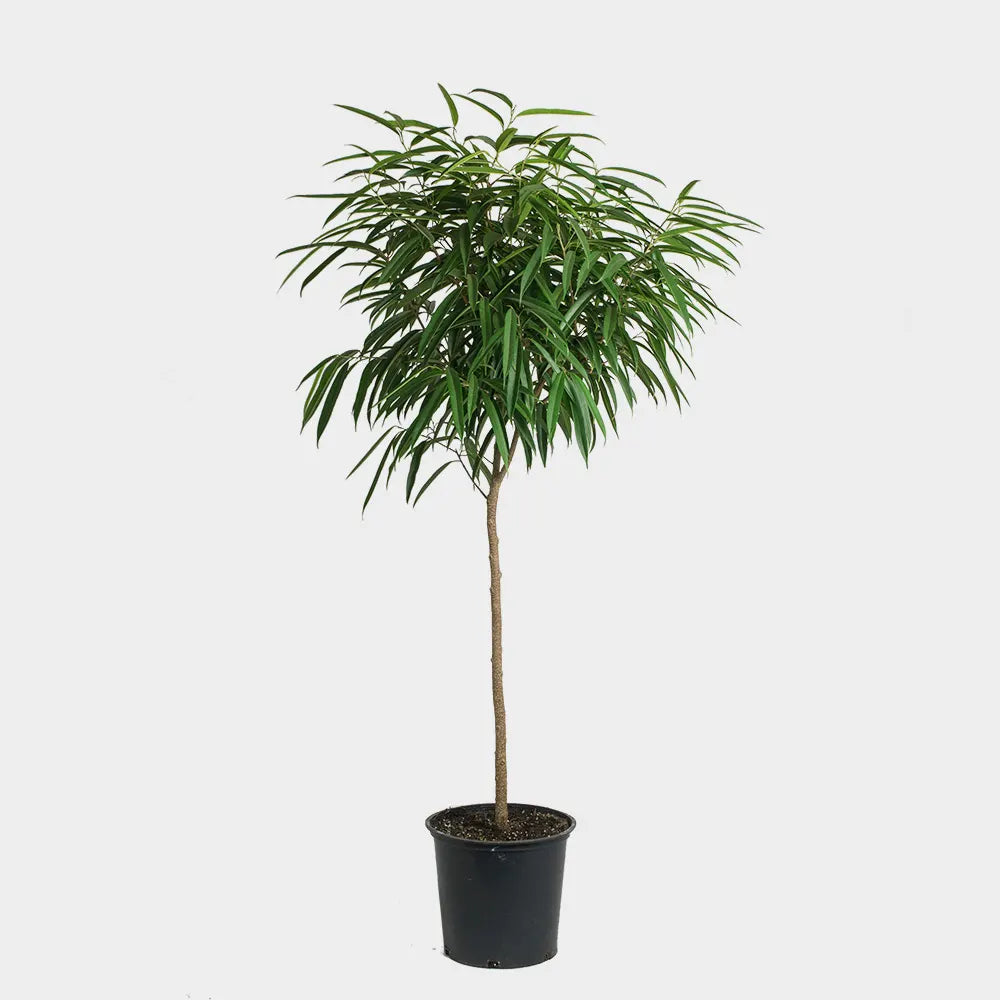Ficus Alli Care
Placement
PRO TIP: The Ficus Alii will grow and lean towards its light source. Rotate your plant periodically to ensure even growth on all sides.
The Ficus Alii (Ficus maclellandii), commonly called the Banana leaf fig for the long and slender shape of its leaves, is a species native to southeastern Asia, India, and China. Easier to care for than its cousins — the Ficus Benjamina and the Fiddle Leaf Fig — the Ficus Alii is also less prone to dropping its leaves due to imperfect environmental conditions. This makes it a less intimidating, but no less dramatic looking, indoor tree.
Similar to most ficus trees, the Alii should be placed where it will receive plenty of bright indirect light. It does not fare well with extended periods of direct sunlight, however, this plant will not tolerate low light conditions. Ideally, place it directly in an eastern facing window or a few feet removed from a southern or western facing window.
If you are unsure about the lighting conditions in your home or office, read our guide for how to measure light in your space.

The Ficus Alii is known for its uniquely shaped slender leaves, which broaden toward the top.
Routine Maintenance
PRO TIP: Prune your Ficus tree to keep its topiary shape — or let it grow into its natural form and take on a fuller, willow-like appearance.
Always be sure to assess your plant’s watering needs upon receiving it. Before giving your plant a drink, it is best to check the moisture level in the soil first to ensure it isn’t moist right beneath the surface. Also, consider aerating the soil of your plant before the initial watering. We compact the soil to avoid shifting during transit, so aerating can help the soil breathe and allow moisture to be released.
Ficus Alii prefer soil that is consistently and evenly moist. You only want to allow the top 1” - 2” of the soil to dry between waterings, but avoid overwatering as they are still susceptible to root rot despite their high moisture requirements. These plants do particularly well in the self watering containers.
The best way we have found to obtain an accurate moisture reading is with the Soil Sleuth Soil Probe. With it, you can check the soil moisture in the different strata of the soil in your pot, while simultaneously aerating the roots and keeping your fingernails free of dirt!
Rotate your plant periodically to ensure even growth on all sides and dust the leaves often so the plant can photosynthesize efficiently. When dusting the leaves, also take the opportunity to inspect the undersides and keep an eye out for pests.
Remember each plant is a unique living thing and may have varying needs, especially in their individual locations. Pay attention to the condition of your Ficus Alii and its watering needs and you will have a long and happy relationship.
Standard Planter Instructions

There are two types of standard planters offered by Greenery NYC—those with drainage holes, and those without. Within those two categories are an array of sizes and styles to choose from. The presence of drainage holes and size of the vessel play a role in the quantity and frequency of water given to your plant.
Plants purchased in a pot without a drainage hole have been set up with a built-in drainage system. A layer of hydro stones (porous, absorbent material made of recycled glass) has been placed beneath the soil to act as a reservoir for any excess water that flows through the soil. You will need to be slightly more cautious not to pour too much water into these containers as there is no way for the excess water to escape. We suggest pouring small amounts of water in bit by bit, until you have reached the desired moisture level in the soil.
For plants potted with drainage, water until it begins to come out the bottom of the pot and into the catch tray.
Always be sure to assess your plant's watering needs upon receiving it. Refer to the routine maintenance section for your plant’s specific moisture requirements.
Self Watering Container Instructions

The self-watering planters require a good, solid watering of the topsoil after they are first placed. This is important because the roots of the plants need to grow into the reservoir first in order to drink from it. Follow the standard planter instructions for the first four weeks. Then the reservoir is ready to be tested.
TEST: After four weeks, fill the water reservoir until the red indicator reaches the MAX line. If the indicator goes down over the first few days, it means the plant is ready for regular reservoir servicing. If not, be sure to continue top watering for a few more weeks, until the red indicator goes down, meaning the plant has started drinking from the reservoir.
RESERVOIR SERVICING: Once the indicator goes down, do not refill the reservoir right away. Similar to how humans need a breath of air between gulps of water, almost all plants require a drying out period. Always allow for the reservoir to empty all the way, and after a drying out period of a few days, be sure to refill it until the indicator reaches the MAX line.
From here on out, you should NEVER topwater the plant. If you water from the top, it can drown the plant. In the Self Watering Container, the top layer of soil will eventually become extremely dry and hard, and may even pull away from the edges of the pot. This is not a cause for concern, but simply because the plant is drinking directly from its roots in the water reservoir.

Step 1: Top water for two weeks. The indicator will look empty, like the picture above.

Step 2: Fill the reservoir until the red indicator reaches the MAX line.

Step 3: Watch the indicator over the next day or two. If it goes down on its own, it means the roots of the plant have grown into the reservoir. From here on out, ONLY water in the reservoir.
Frequently Asked Questions
Help! My Ficus Alii is dropping leaves.
- Dropping leaves can be a sign of transplant or environmental shock, but if the dropping persists it’s best to check in with the moisture levels in the soil. Dropping leaves can also indicate that the moisture levels in the soil need adjusting. How can you tell the difference? The easiest way is to feel the soil: If it feels dry then you are likely underwatering. If it feels moist then the plant is probably holding too much water. Additionally, look at the discoloration on the fallen leaves. Overwatering is usually indicated by brown tips followed by yellowing, while underwatering is often fully yellow or brown crispy leaves.
Are Ficus Alii difficult to care for?
- The Ficus Alii is typically easier than most other Ficus varieties. It acclimates well to new spaces, it’s less finicky about water, and it doesn’t need quite as much light. We consider it a medium level tree in terms of difficulty.
Can I place my Ficus next to an AC or heating vent?
- It is best not to. Ficus are sensitive to hot and cold air drafts. They prefer humidity and warm temperatures, so anything to aid in maintaining a tepid environment will help keep your plant happy and healthy.
How often should I fertilize my plant?
- In general, house plants will thrive when they are fertilized spring through fall. Fertilize once a month with an organic houseplant fertilizer, following the package instructions for dilution and administration. Greenery NYC uses an organic potting mix with a slow release fertilizer in the soil, so your plant will not need fertilizer within the first 6 months of receiving it.
How often does my plant need to be repotted?
- For larger floor plants, we suggest repotting every 18-24 months. Typically you want to choose a potting vessel 2”- 4” larger in diameter to allow for growth. Don’t choose a pot much larger than the previous as this could drown the plant's roots. If you prefer to maintain the current size of your plant, repot into the same vessel, providing new soil and trimming away some roots and foliage. Spring or summer is the ideal time to repot as the plant is at its strongest.
Additional Care Guides
email signup
Get the first look at new products, collaborations, events, sales and more


